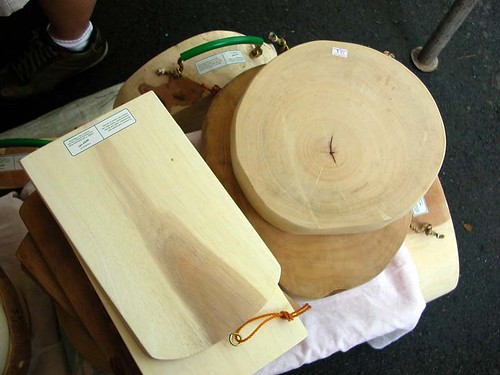
i bought a couple of cutting boards when i went to the salcedo market: a round chunk from the trunk of a tamarind tree, and a rectangular one hewn from an acacia tree; i also bought a very nice mortar and pestle made from tamarind wood. all three pieces were had for the very nice price of about US$12.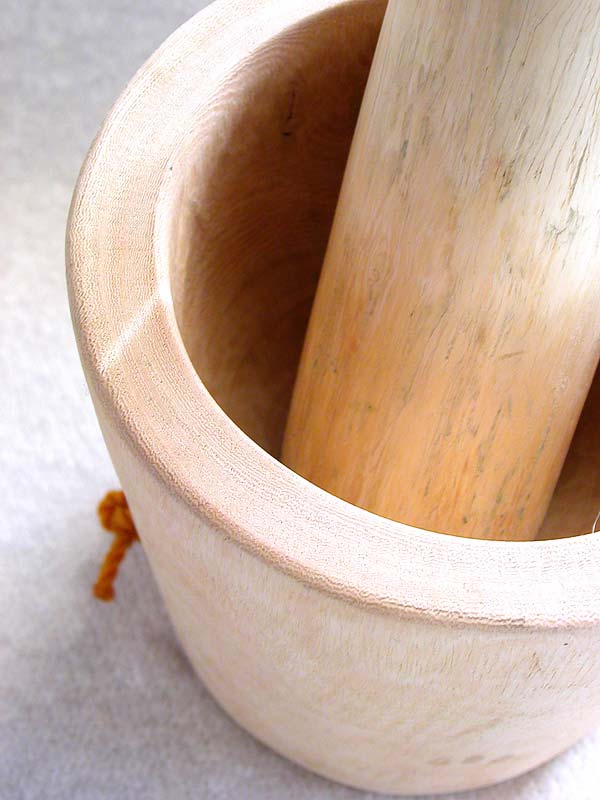
unfortunately, when i got back to guam, i noticed that there was some cracking in the tamarind wood pieces--i think that the change in altitude/cabin pressure during the flight had something to do it (either drying out the wood, or something else that would cause it to contract and expand). the acacia board did not suffer, but perhaps all the boards could have benefited from a thorough oiling/seasoning before making the flight.
generally, you should oil your untreated wood cutting boards to seal the grain from bacteria, prevent absorption and staining, but it also keeps the wood moisturized and prevents splitting and cracking. you should oil a board thoroughly before you begin using it, and regularly wipe it down to nourish it.
use a neutral food grade oil that will not go rancid. i used mineral oil because it's relatively inexpensive and readily available. all you really need is the oil, a lint-free cloth, and some newspaper. 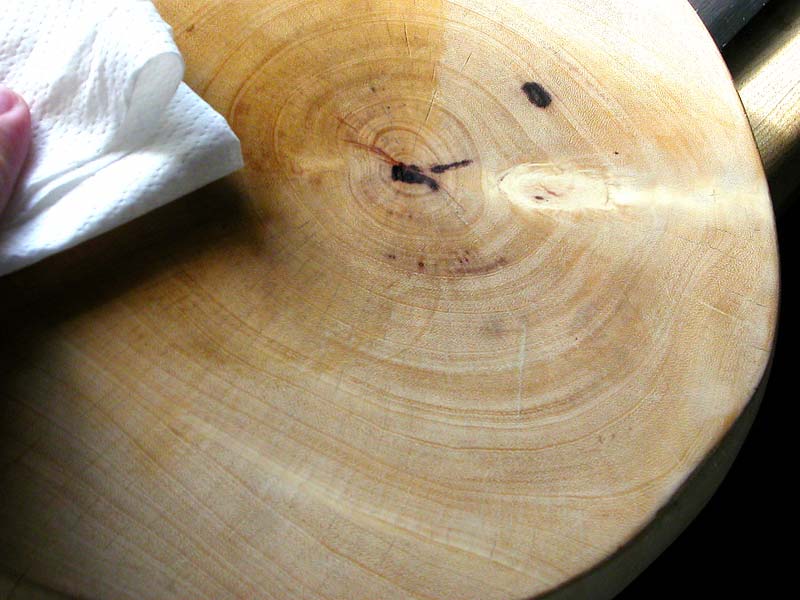
there are two ways that i know of for oiling a board. the first way is to warm the oil slightly and apply it with a cloth, in the direction of the grain. allow the oil to soak through for several hours, then wipe down any excess oil. apply several more coats (four or five), leaving it to sit between each application.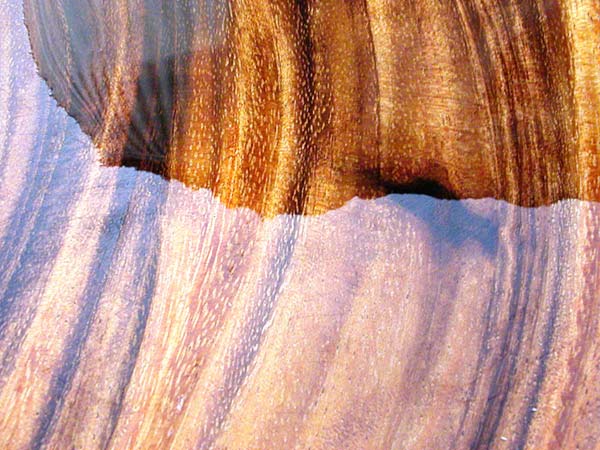
the other way to set the board on several layers of newspaper, pour the oil liberally onto the wood surface, and leave it to soak overnight. wipe down any excess oil the next morning. after this initial process, apply some oil to the board on a regular basis--monthly if it's used daily, and at your discretion for occasional use.
another advantage? it brings out the grain of the wood beautifully.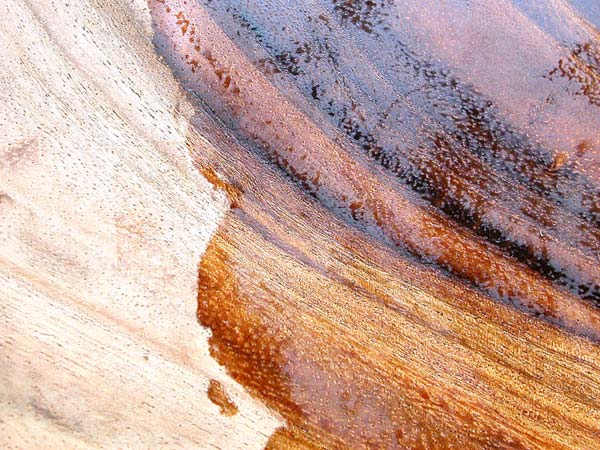
20051017
the care and feeding of a cutting board.
Labels:
manila
,
market
,
philippines
Posted by
santos.
This entry was posted on 20051017
at
8:54 PM
You can skip to the end and leave a response.
Subscribe to:
Post Comments (Atom)




11 comments:
10/18/2005 08:06:00 AM
oohh... i'm green (bananas) with envy!
10/18/2005 12:45:00 PM
Hi Santos!
Great! Now I know what to do when I get a new chopping board...Do you think I should start oiling my recently acquired but already in use chopping board?
10/18/2005 01:23:00 PM
hi bramble! :D funny woman.
hi mumu! i was just admiring your pleating on the dumplings you made. you know, you have a good question. i don't know if it's a good idea to oil a board already in use, especially if it's used for meats. maybe if you wash it and sand it down a bit, but it might be better to just leave it alone.
can anyone help?
10/18/2005 04:12:00 PM
On our last trip I - too - bought some new chopping boards. My new favorite is made of olive wood. While the ones I inherited by my grandma never saw a drop of oil (obviously!), I oiled the new ones as soon as I got home...
Thanks for the great post :)
10/18/2005 04:36:00 PM
hey santos, thanks for the wealth of terrific tips...i am gawking at that mortar & pestle; it really is gorgeous...in your shoes, i would have snatched one up too...
10/18/2005 05:26:00 PM
hello nicky! i've enjoyed your posts about colorado--i haven't been there in years, but i have some fond memories.
the cutting boards we have in the philippines never see oil, either, although they are so inexpensive that i believe they are replaced on a regular basis. i noticed in the market that the vendors used the round trunk boards as the cutting board of choice for chopping up roast pork, and those weren't oiled either. they aren't used for raw meat, nor as they used for anything else, so i'm sure they are fine. overall, i believe that wood, untreated or not, is more hygienic than plastic cutting boards, but i don't really want to be lugging chunks of lumber across the pacific every time i need a new one :)
hi j--it's lovely, isn't it? it's quite substantial, as well, and holds a good cup and a half in its well. i used it last night and was pleased by its efficiency--i thought the wood would make it more difficult to grind spices, but i didn't have to exert an extra effort.
10/20/2005 03:02:00 PM
har, hrh, har. actually, in this case yes because the ticket was free.
and if it was a choice of paying for a ticket or killing someone for a cutting board, i'd pay for the ticket!
10/21/2005 02:34:00 PM
If you can get it, cutting boards also love pure beeswax. And after massaging it into the cutting boards, your hands appreciate its properties too.
When I can't get this, though, I use canola oil.
It's a great subject to address, I am always seasoning everyone's cutting boards and cast iron pans.
10/21/2005 02:42:00 PM
beeswax! :) actually, what a good idea. do you do either wax or oil, or can you do both? if i've already oiled the boards, is it too late to wax? or do you wax then oil or am i thinking of depilation and bikini waxes (eyuw).
aww, shuna, you are too nice (or do you just hate to see a good board go to waste? ;)).
2/23/2006 05:01:00 PM
Hi! I just recently bought a board and I oiled it before use with mineral oil. However, I've noticed that it has warped in the middle. Anyone have any idea why that would happen? Any help would be appreciated! Thanks!
2/23/2006 07:11:00 PM
hi rhema--your board could either have been raw wood, or improperly dried to begin with, so it could have warped when placed in a hot area allowing the water within the board to leech out. was their mildew on it? the other thing is that despite being sealed, it was still somehow soaked in water (if you submerged it in water or put it through a dishwasher, that can happen). extreme cold, heat, or humidity will warp them too.
i think there is a way of repairing warped boards but i'm not sure what it involves.
hope some of this helped!
Post a Comment